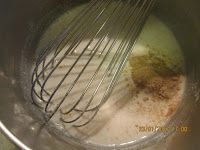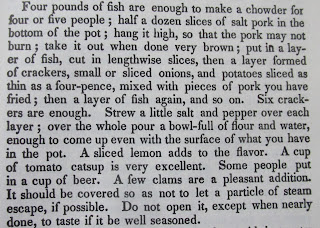The American Frugal Housewife by Lydia Maria Child, first published in 1829 as The Frugal Housewife, Dedicated to Those Who Are Not Ashamed of Economy, seems a fitting choice for January. Mine is the commonly-available Dover reprint of the 1844 edition.
The book is not only a cookery book, and the majority is about general household economy, including "Simple Remedies" for various ailments and how to remake bonnets, clean brass, and get rid of ants. She also tells how to choose meat and store vegetables, and an Appendix at the end includes additional items such as getting rid of ear wax, preserving various fruits, and something appropriate to my current weather: "Icy Steps - Salt strewed upon the door-steps in winter will cause the ice to crack, so that it can be easily removed." Two substantial sections are stories (really, moralizing lectures) about living economically, intriguing for their perspectives on the society of the day.
Browsing the main sections, I found this recipe:
A pound of fish per person sounds like quite a lot, but this is fish entire, with the bones and skin and fins and such. Fillets would be about half that quantity, and I happened to have some salmon in the freezer that I thought would do, once the skin is removed. In the interest of frugality and using my current pantry, the only item I needed to buy was a potato.
Fish chowder alone isn't a full meal, so I looked for a dessert. In terms of simplicity, frugality, and midwinter-ness, a pudding seemed the best option. Given that most of the puddings were boiled, and I've never done a boiled pudding, the one baked pudding was the answer. Finally, to round out the meal further, some vegetable is in order. Browsing that section, which speaks more of storage than cooking, I noticed a recipe for stewed tomatoes. That may not sound practical in January, but I had put tomatoes by in the freezer during the summer when my CSA had them in plenty, and that seemed a nice, easy way to round out the meal. Plus, the chowder recipe mentioned adding tomato catsup (the recipe she included, not the insipid sweet stuff available commercially today) so it sounded as if the tomatoes would be compatible.
First to be prepared is the pudding, as it takes longest - "three or four hours" - to bake. I had a pint bottle of milk in the 'fridge from another recipe that didn't get made, so halved the ingredients - and made a few adjustments.
I do not have molasses in the pantry, and my supply of maple syrup (my usual go-to with corn porridges) is running a bit low. However, preserves and jam can be used as sweetening; I have some recipes that call for it specifically. After checking what I have, I selected some peach jam as it is on the runny side (no pectin used) and I thought would go well with the ginger.
Although we don't need to scald milk for safety since pasteurization became the norm, I did heat the milk to just below a simmer. Then I stirred in three and a half tablespoons of cornmeal; a half-teaspoon of salt; and a heaping teaspoon of ground ginger.
How much jam to add? I estimated that a teacup would hold 4-6 ounces of tea, so I added four tablespoons (two tablespoons to a liquid ounce). I whisked everything in the pot, and then poured it into the enameled cast-iron casserole, which is a family item that was passed down to me a number of years ago, and seemed appropriate to use.
 |
| Stirring in salt and ginger; cornmeal has already been added to the milk. |
 |
| The jam fell under the surface quickly! |
Two hours later, beginning the chowder. This time I was making a one-fourth recipe, since I had about a half-pound fillet, but given that there are no specific amounts in this recipe other than the meats (fish and salt pork) and crackers I went by guesswork. I skinned the filet and cut it into pieces. Having been frozen, it was somewhat soft, so I had some slices and some bits. At least they get hidden in the course of the cooking!
 |
| Pantry ingredients, plus potato. |
 |
| Salmon, thawed, beginning to slice. |
For the salt pork I used three slices of bacon. I fried it in a pot, then poured the grease into the bottom of a Pryex® casserole. I thought if the layers were pretty, I'd get a side shot. I followed the layering pretty much as instructed, using all of the onion and about three-quarters of the potato. I'd guesstimated the packet of crackers would be equal to about one and one-half common crackers.
 |
| Fish on the bottom, then sliced onion, potato slices, and cooked bacon. |
 |
| Second set of layers, crackers more visible this time. |
Of course there is no quantity or proportion for the "flour and water", just to pour it to the top level of the contents of the dish. I started with 3/4 cup of water and two tablespoons of flour. Then I added another half-cup of water to bring it just to the top.
 |
| Peeking at the pudding. |
Something I didn't photograph was adding a couple tablespoons of apple cider vinegar just before putting the chowder into the oven. Why? If you look at the recipe, she suggests a number of things to add flavour. Lemons were $1.49 at the store, not very frugal! I don't have homemade tomato catsup and didn't want to create it when I needed a most a quarter of a cup. I don't have clams, and I didn't want to use beer since I wasn't doing anything with the rest of the bottle. But vinegar often stands in when something tangy is wanted, and I do have that, so I thought I would add just a bit, about as much as one-fourth of a lemon.
I took a look at the pudding when I put the chowder into the oven. It's hard to see in the photograph, but it is still somewhat runny, although medium-thick. I would eat it at this stage for morning cereal.
A little under two hours later, I put the tomatoes (partially thawed because I had not taken them out very early) in the pot that still had a bit of the bacon grease in it. Mrs. Child's recipe says to add butter, but I figured I would be frugal and use what there is.
So I heated the tomatoes and cooked off the water that separates out when you freeze and thaw tomatoes. It's not a problem if you are turning them into sauce or another cooked preparation, and it meant I didn't add the recommended "spoonful of water, to keep them from burning".
After two hours of baking the potato slices in the chowder were soft, so I decided that dinner is ready to serve!
 |
| The pudding has an almost cakelike crust on the sides. I am very glad that I thought to grease that casserole! |
The chowder was definitely a good item. Unlike modern chowders which are soup this is a solid casserole of a dish. The fish was not prominent, probably because I didn't have much of it. The vinegar was just barely there, alleviating what could have been pasty-white blandness. Ditto the bacon, which of course softened but added a bit of smokiness that might not have been present had I used uncured bacon or salt pork. I could have chopped it into smaller bits and the bacon would have blended in better, but it was pretty good. The crackers and flour-water dissolved to bind everything together silkily.
As for the pudding? WOW. I love Indian pudding and similar things anyway. I can see why people serve it with thick cream, that would really have made it wonderful. Even without anything on top it's still very good, with the ginger showing up on about the third spoonful. There's no distinct taste of peach, the jam just added sweetness.
These left plenty of leftovers. I heated up some of the pudding for breakfast today, and it's still light, not dense, with the ginger a bit more prominent. I'm going to top it with some vanilla yoghurt to finish, and will heat up the chowder for lunch.
BONUS RECIPE: I am in a couple of book clubs, and this month both are reading Hidden Figures. I decided to make a recipe from a cookbook of about that era to serve as snacks, and selected "Gumdrop Cookies" from the Better Homes & Gardens New Cook Book, Revised Edition © Meredith Publishing Company 1953, 1962:
Because this post is so long already, I am not going to add lots of photos of the process. It was very straightforward because this is a modern recipe. I halved the quantities and used Bob's Red Mill Gluten-Free All-Purpose Baking Flour because one club has some people who need to avoid gluten. This made the cookies a bit more crumbly that the cookies might have been otherwise. Also, I used butter because I didn't have shortening. I used only the green gumdrops, because I thought it would be more palatable to keep to a single flavour, and I don't like green gumdrops.
 |
| After baking - firm, brown underneath but still light on top. |







No comments:
Post a Comment